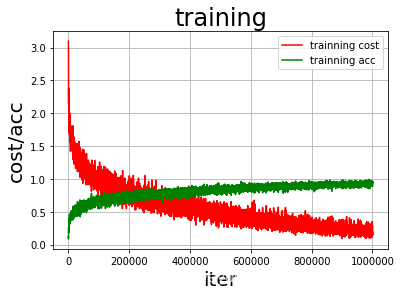原文博客:Doi技术团队
链接地址:https://blog.doiduoyi.com/authors/1584446358138
初心:记录优秀的Doi技术团队学习经历
说明
这个是使用PaddlePaddle训练cifar10数据集的一个例子
问题1:网络结构
问题:计算每层网络结构和输入输出尺寸和参数个数。不加BN?更深?每层的尺寸变化?更多结构?
def convolutional_neural_network(img):
print('输入层的shape:', img.shape)
conv_pool_1 = fluid.nets.simple_img_conv_pool(
input=img,
filter_size=5,
num_filters=20,
pool_size=2,
pool_stride=2,
act="relu")
print('第一层卷积池化层输出shape:', conv_pool_1.shape)
conv_pool_1 = fluid.layers.batch_norm(conv_pool_1)
conv_pool_2 = fluid.nets.simple_img_conv_pool(
input=conv_pool_1,
filter_size=5,
num_filters=50,
pool_size=2,
pool_stride=2,
act="relu")
print('第二层卷积池化层输出shape:', conv_pool_2.shape)
conv_pool_2 = fluid.layers.batch_norm(conv_pool_2)
conv_pool_3 = fluid.nets.simple_img_conv_pool(
input=conv_pool_2,
filter_size=5,
num_filters=50,
pool_size=2,
pool_stride=2,
act="relu")
print('第三层卷积池化层输出shape:', conv_pool_3.shape)
prediction = fluid.layers.fc(input=conv_pool_3, size=10, act='softmax')
print('全连接层输出shape:', prediction.shape)
return prediction
卷积层输出计算公式:
- 输入shape:
- 卷积核shape:
- 输出shape:
池化层输出计算公式:
- 输入shape:
- 池化shape:
- 输出shape:
参数大小计算公式:
答1: 本网络的的输入数据的shape为(128, 3, 32, 32),所以输出如下:
- 第一层的卷积层输出shape:(128, 20, 28, 28),参数大小为:
- 第一层的池化层输出shape:(128, 20, 14, 14)
- 第二层的卷积层输出shape:(128, 50, 10, 10),参数大小为:
- 第二层的池化层输出shape:(128, 50, 5, 5)
- 第三层的卷积层输出shape:(128, 50, 1, 1),参数大小为:
- 第三层的池化层输出shape:(128, 50, 1, 1)
- 最后的全连接层输出shape:(128, 10),参数大小为:
- 总参数大小:
PaddlePaddle的网络输出
输入层的shape: (-1, 3, 32, 32)
第一层卷积池化层输出shape: (-1, 20, 14, 14)
第二层卷积池化层输出shape: (-1, 50, 5, 5)
第三层卷积池化层输出shape: (-1, 50, 1, 1)
全连接层输出shape: (-1, 10)
答2:
在没有使用BN层之前:
- 参数的更新,使得每层的输入输出分布发生变化,称作ICS(Internal Covariate Shift)
- 差异hui会随着网络深度增大而增大
- 需要更小的学习率和较好的参数进行初始化
加入了BN层之后:
- 可以使用较大的学习率
- 可以减少对参数初始化的依赖
- 可以拟制梯度的弥散
- 可以起到正则化的作用
- 可以加速模型收敛速度
用BN层的训练情况:

不使用BN层的训练情况:

从图中可以看出使用BN层的准确率更高,训练过程中损失值和准确率的幅度更加小。
答3: 因为该网络的第三层卷积池化层输出的宽和高都是1,所以不能再增加卷积池化层,如果再使用卷积池化层,就会报以下的错误。
EnforceNotMet: Due to the settings of padding(0), filter_size(5), dilation(1) and stride(1), the output size is less than 0, please check again. Input_size:1